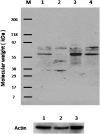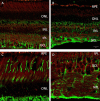Genome-wide association study of advanced age-related macular degeneration identifies a role of the hepatic lipase gene (LIPC)
- PMID: 20385826
- PMCID: PMC2867697
- DOI: 10.1073/pnas.0912019107
Genome-wide association study of advanced age-related macular degeneration identifies a role of the hepatic lipase gene (LIPC)
Abstract
Advanced age-related macular degeneration (AMD) is the leading cause of late onset blindness. We present results of a genome-wide association study of 979 advanced AMD cases and 1,709 controls using the Affymetrix 6.0 platform with replication in seven additional cohorts (totaling 5,789 unrelated cases and 4,234 unrelated controls). We also present a comprehensive analysis of copy-number variations and polymorphisms for AMD. Our discovery data implicated the association between AMD and a variant in the hepatic lipase gene (LIPC) in the high-density lipoprotein cholesterol (HDL) pathway (discovery P = 4.53e-05 for rs493258). Our LIPC association was strongest for a functional promoter variant, rs10468017, (P = 1.34e-08), that influences LIPC expression and serum HDL levels with a protective effect of the minor T allele (HDL increasing) for advanced wet and dry AMD. The association we found with LIPC was corroborated by the Michigan/Penn/Mayo genome-wide association study; the locus near the tissue inhibitor of metalloproteinase 3 was corroborated by our replication cohort for rs9621532 with P = 3.71e-09. We observed weaker associations with other HDL loci (ABCA1, P = 9.73e-04; cholesterylester transfer protein, P = 1.41e-03; FADS1-3, P = 2.69e-02). Based on a lack of consistent association between HDL increasing alleles and AMD risk, the LIPC association may not be the result of an effect on HDL levels, but it could represent a pleiotropic effect of the same functional component. Results implicate different biologic pathways than previously reported and provide new avenues for prevention and treatment of AMD.
Conflict of interest statement
Conflict of interest statement: Tufts Medical Center (J.M.S.) and Massachusetts General Hospital (M.J.D.) have filed a joint patent application for materials related to this manuscript.
Figures


References
-
- Seddon JM, Sobrin L. Epidemiology of age-related macular degeneration. In: Albert D, Miller J, Azar D, Blodi B, editors. Albert & Jakobiec's Principles and Practice of Ophthalmology. Philadelphia: Saunders; 2007. pp. 413–422.
-
- Haines JL, et al. Complement factor H variant increases the risk of age-related macular degeneration. Science. 2005;308:419–421. - PubMed
-
- Edwards AO, et al. Complement factor H polymorphism and age-related macular degeneration. Science. 2005;308:421–424. - PubMed
Publication types
MeSH terms
Substances
Grants and funding
- R01 EY013435/EY/NEI NIH HHS/United States
- R01-EY13435/EY/NEI NIH HHS/United States
- R01 HL087676/HL/NHLBI NIH HHS/United States
- R01 EY009769/EY/NEI NIH HHS/United States
- R01-EY11309/EY/NEI NIH HHS/United States
- K12 EY016335/EY/NEI NIH HHS/United States
- K12-EY16335/EY/NEI NIH HHS/United States
- R01 EY011600/EY/NEI NIH HHS/United States
- R01 EY011309/EY/NEI NIH HHS/United States
- K08 AR055688/AR/NIAMS NIH HHS/United States
- R01-EY11600/EY/NEI NIH HHS/United States
- R24 EY017404/EY/NEI NIH HHS/United States
- U54 RR020278/RR/NCRR NIH HHS/United States
- R24-EY017404/EY/NEI NIH HHS/United States
LinkOut - more resources
Full Text Sources
Other Literature Sources
Medical
Molecular Biology Databases

